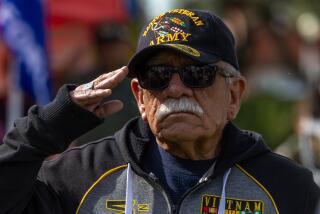Give Thanks for These Patriots
- Share via
It is all too easy to take the all-volunteer armed forces for granted. They’ve been around now for 31 years, ever since the draft was abolished in 1973. We have become used to having a high-quality military filled by dedicated young women and men willing to put their lives on the line for less money than Donald Trump hands out in tips every week.
It is worth remembering how extraordinary and unusual our service members really are -- and how much we owe them this Thanksgiving.
The voluntarism tradition stretches far back in U.S. history, all the way to the colonial militias, but it has never produced such a superb fighting force. For most of their history, the peacetime Army, Navy and Marine Corps were laughingstocks that could not compete with the world’s best. The entire armed forces in the 19th century usually numbered no more than 35,000 men -- smaller than the New York Police Department today. Traditionally, they were so ill prepared that they wound up losing critical early battles, from the Civil War’s Bull Run (1861) to World War II’s Kasserine Pass (1943).
To get a sense of the old military, read two novels written by veterans (and made into memorable movies) -- Richard McKenna’s “The Sand Pebbles” and James Jones’ “From Here to Eternity.” Both were populated by misfits, “lifers” for whom the military was a welcome alternative to the penitentiary or the poorhouse.
The hegemony of the hard-bitten regulars ended in 1940, with the introduction of a draft that lasted until the last years of the Vietnam War. In their post-Vietnam agony, all the services had trouble attracting recruits, and those who signed up tended to come from the bottom of the barrel -- half were not even high school graduates. Low morale, racial tensions and drug and alcohol abuse were rife in the 1970s.
By the 1991 Persian Gulf War, those problems had evaporated. Entry standards for volunteers were higher, the quality of recruits improved, and the first-rate military we know today was created -- a military force that is better educated than the civilian population, whose enlisted ranks are composed of high school graduates and whose officers are college graduates (many with graduate degrees). A force in which drug use has fallen into insignificance and morale and discipline are sky-high. A dedicated, courageous, professional force capable of knocking the stuffing out of just about any foe, anywhere in the world, at a moment’s notice.
Some antiwar protesters want to spread the idea that the military is composed of victims who have no alternative but to become cannon fodder. Nothing could be further from the truth, especially in front-line combat units in which everyone is a volunteer twice over.
Why do they do it? Why have 1.5 million men and women enlisted in the active-duty military, and 861,000 more in the National Guard and Reserves? The reasons vary, of course. Many are drawn by the prospect of learning a trade or earning a college scholarship. Others want an adventure or a sense of purpose. Once they spend some time in the service, the pull of camaraderie leads many to reenlist.
But it would be a mistake to overlook the simplest and most obvious motive of all: patriotism. People pull on their BDUs (battle dress uniforms) out of a desire to defend a great nation. Such sentiments can sound corny in today’s ironic culture, but the military is one place where old-fashioned pieties are uttered without a subversive smirk.
The all-volunteer force is now being tested as never before; it’s never had to fight a war as prolonged as the one in Iraq. The media naturally tend to focus on problems -- small numbers of soldiers who refuse to obey orders or break the laws of war, reservists who fight recall to duty or complain about their hardships. This is to be expected. What’s amazing is not how many problems the military is experiencing but how few.
In spite of a punishing operations tempo and dismaying shortages of critical equipment like armored Humvees and the latest body armor, today’s GIs soldier on. They undertake incredibly difficult and dangerous assignments like the assault on Fallouja with less grumbling than the average commuter stuck in a traffic jam.
There is no way that we civilian turkey-eaters can properly show our gratitude for those whose Thanksgiving meal comes in a chow hall thousands of miles from home. But for a start we can at least contribute to a number of charities that provide important aid to service members and their families. For a list, go to www.defendamerica.mil and click on “Support Our Troops.”


